Press Conference
EMO MILANO 2015
China Machine Tool & Tool Builders’ Association
Ladies and gentlemen,
Good morning!
First of all, please allow me,on behalf of China Machine Tool & Tool Builders' Association, to express awarm welcome and heartfelt thanks to guests and friends from all walks of lifeattending today's press conference!
In today's press conference, wewill introduce the following aspects: China's economy, China's machine toolconsumer market and the China CNC Machine Tool Fair 2016 (Abbreviated asCCMT2016) to you.
1. China's economy
China is the world's secondlargest economy, and its economic aggregate has been more than USD10 trillion since2014. Especially after the global financial crisis in 2008, the Chinesegovernment implemented a massive economic stimulus plan (RMB4trillion) toexpand domestic demand, so as to stimulate China's economy quickly out of thecrisis, and to maintain high- speed growth. It has to be pointed out that China'sdomestic demand growth, motivated by China's economic stimulus plan,objectively strongly supported the global economy to avoid a deeper recessionin the world's major economies as well. The contribution to global economicgrowth was more than 50%, and even after obvious slowdown of China's economicgrowth in 2013, China's contribution to global economic growth still reachednearly 30%.
In view of China's increasinginfluence on the global economy, the change of China's economy is getting moreand more attention from the whole world.

DataSources:National Bureau ofStatistics of the People’s Republic of China
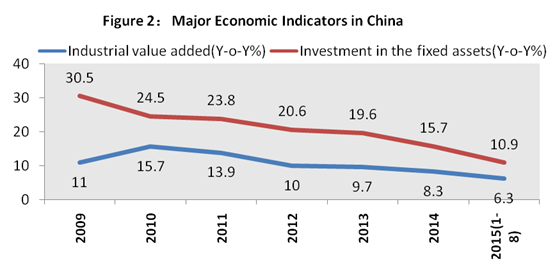
DataSources:National Bureau ofStatistics of the People’s Republic of China
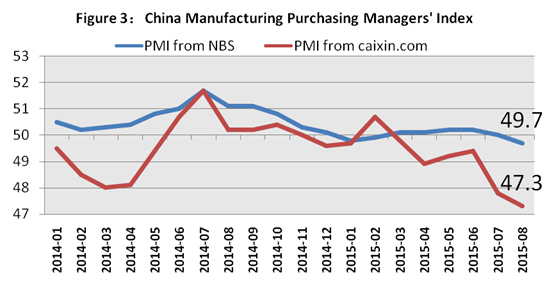
DataSources:National Bureau ofStatistics of the People’s Republic of China, www.caixin.com
Figure 1, figure 2, and figure3 showthe changes of several China's economic indicators, closely related to China'smachine tool consumer market in recent years. It can be seen that since 2012,China's economy has entered the middle high-speed growth phase from the longperiod of high-speed growth presenting an overall downward trend.
In the first half of this year,China's economy further slowed down, and the GDP growth fell to 7%. Especially,the stock market fell since mid-June, the reform of quotation mechanism of foreignexchange parity for RMB & U.S. dollar and the corresponding devaluation ofthe RMB since August caused a widespread concern in the world about China'seconomy, which impacted the global capital market a great fluctuation for atime.
How to understand the currentsituation of China's economy and how to judge the future of China's economyhave become one of the focus of attention and controversy in the world economiccommunities.
We believe that we mustunderstand and judge China's economy in a comprehensive, rational and objectivemanner. From this point of view, we mainly have the following understanding ofChina's economy:
- The downward pressure onChina's economy is indeed strong, and also with many difficulties, but China'seconomy still maintains at a reasonable operating range;
- The problem of China's economyhas derived from the process of reform and adjustment, so it is a problem in theprocess of progress and a temporary one.
- A strategic vision is neededto observe China's economy as President Xi Jinping recently stated to"look at whether the direction is right or not, whether the driving forceis strong or not and whether the potential is abundant or not".
To illustrate the abovecomprehension, I'd like to give you the following groups of data:
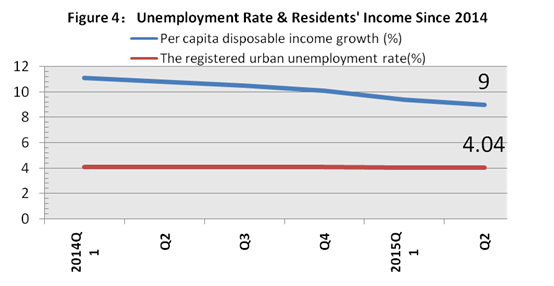
DataSources:National Bureau ofStatistics of the People’s Republic of China
Figure 4 is the situation of China'semployment rate and household income since last year. As seen in the figure,although the economy further slowed down in the first half of this year, theemployment rate remained stable. In the first half of this year, the actualincrease in employment was 7.18 million people, which is 72% of the annualtarget. It can also be seen from the figure, although the growth rate of disposalincome per capita shows a downward trend, at the end of the second quarter thisyear, the data is still up to 9%, continuing to be higher than the GDP growthrate (7%) in the same period. Ensuring employment and income growth are thebasic starting point and foothold of economic development. Therefore, it is oneof the bottom lines of macro adjustment and control of China's economy. Despitea further slowdown in the GDP growth, the good performance of the employmentand income growth have provided enough support for China's comprehensiveeconomic reform and economic structural adjustment.
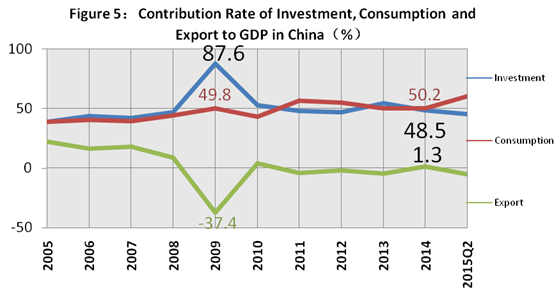
DataSources:National Bureau ofStatistics of the People’s Republic of China
Please look at another group ofdata. Figure 5 is the contribution of investment, consumption and exports tothe GDP growth in 10 years. It can be seen that before 2008 China's economicgrowth was jointly pulled by "three-in-hand" for investment,consumption and export and their contribution to the GDP growth basicallymaintained balance; in 2009, due to the global financial crisis and the effectof China's massive stimulus plan, the economic growth driving force experiencedserious structural imbalance. The contribution of investment to economic growthreached a record 87.6%! While the contribution of exports to economic growthhas reached a record of minus 37.4%! Since 2010, China's economic growth was infact pulled by "two-horse-carriages" of investment and consumption,due to influences of multiple factors that the global market demand droppedsignificantly and China's export competitiveness weakened and etc....We've particularlynoted that consumption has replaced investment becoming the first driving forcefor economic growth in China since 2011. In the first half of this year, thenumber has reached 60%! This is not the case for a long time, while thissituation is the main pursuant goal of China's economic structural adjustment,which is to achieve the economic growth model mainly relying on consumptiondrive.
It is not difficult to draw aconclusion that despite the slowdown in the growth rate brought by China'sactive economic structural adjustment to a certain degree, but it has triggeredthe gradual optimization of the economic structure. In other words, we useeconomic growth slow down as the price for the long-term sustainable andhealthy development of the economy in return. This is not only significant forthe future of China's economy, but also will have a positive impact on theglobal economy.
When it comes to China'seconomy, we have to give you a brief introduction to the change of China'sstock market and foreign exchange market, because this is the main cause ofcommon concern about China's economy.
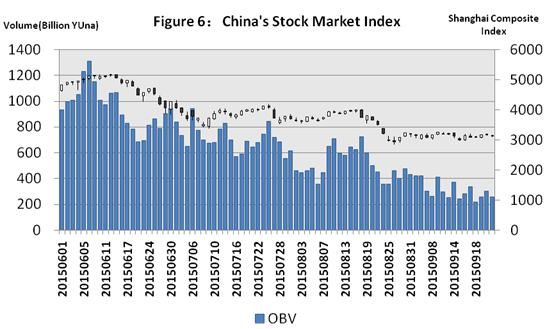
DataSources:China SecuritiesRegulatory Commission
First, the stock market. DuringMarch to June this year, the Shanghai Composite Index rose up to 70%, and thestock market bubble accumulated rapidly. Figure 6 is the change of ShanghaiComposite Index in two and three quarters. The figure shows that sincemid-June, the stock market had experienced three adjustments. The first tworounds of adjustments did not cause international influence, but in lateAugust, the third round of adjustments had a global impact. The Chinesegovernment took effective measures to provide liquidity to the market throughvarious channels to prevent the occurrence of systemic financial risks. Toearly September, the adjustment of stock market has been generally in placeentering the stage of self-repair and self-adjustment.
Now come to the foreign exchangemarket. On August 11th, China's central bank announced the reform of quotationmechanism of the foreign exchange parity of the RMB and U.S. dollar, whichstarted a new round of exchange rate reform in china. In that time, the RMBexchange rate faced a great depreciation pressure, but now it has graduallystabilized. On September 17th, the State Administration of Foreign Exchange announcedthe pressure of the depreciation of the RMB has basically released, whichmarked the new reform had come to an end. Figure 7 is the changes of middlerate of RMB against U.S. dollar exchange rate in the third quarter of thisyear, which also shows the RMB exchange rate against the euro.
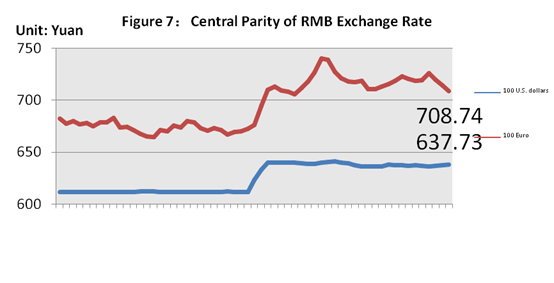
DataSources:State Administration ofForeign Exchange
Chinese Premier Li Keqiang lastmonth attended the Davos forum held in Dalian, China in the summer. On onehand, he does not deny the difficulties currently China's economy is facing; onthe other hand, he is also full of confidence on China's economy. He pointedout "despite the stronger economic downward pressure in recent years,China did not issue excessive currency, and did not carry out large-scalestimulus. This left space for the next step of adjustment." "Thereare still a lot of tools in the toolbox of China's innovative macro-controlpolicies." "Once the economy has the possibility to slip out of areasonable range, we have enough ability to deal with it," "China'seconomy will not appear to be 'hard landing’; this is not an empty talk."
2. Chinamachine tool consumer market
(1) Market overall situation
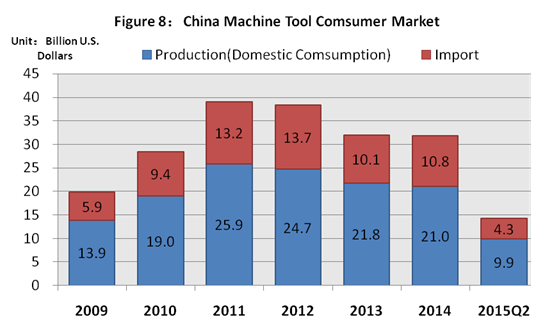
DataSources:CMTBA
Figure 9:The Main Direction of the Upgrade of DemandStructure

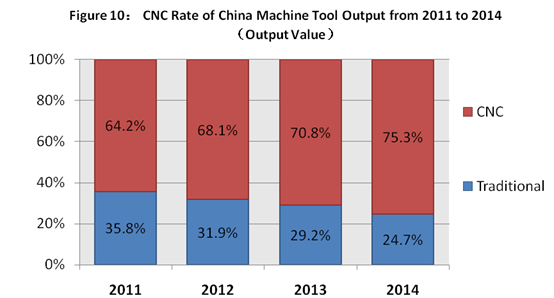
DataSources:CMTBA
Under the influence of theglobal economic rebalancing, especially of China's economic structuraladjustment and growth slowdown, China's machine tool consumer market haschanged significantly in recent years. The basic characteristics of the changesare in the two aspects. On one hand, the total market demand is significantlyreduced, of which the demand for low-end homogeneous products and heavy dutymachine tool products declined particularly prominent. Figure 8 reflects theabove trend. On the other hand, the market demand structure shows a rapidupgrade. The main direction of the upgrade is the automatic complete set,customization and general shift to the upgrade(Figure 9). Among them, the market demand growth for automatic complete sets ofequipment is particularly significant, which origins not only from the users needof upgrade of China's machine tool, but also from a significant changes of therapid increase in China's labor costs and labor supply and demand relation.Figure 10 shows the numerical control rate of output of China's machine toolmanufacturing in recent years (calculated by output value). It can be seen inthe 4 years when the total demand quantity of China's machine tool consumermarket has been significantly reduced, the numerical control rate of China'smachine tool manufacturing output is in rapid optimization. Compared with 2011,the data increased by 11.1 percentage points in 2014, which from one sidereflects the characteristic of general shift to upgrade in China's machine tool market.
On the basic characteristics ofchanges of China's machine tool consumer market, we want to do the following explanation:first, because the most significant market demand decline is the low -endhomogeneity products and most of which are manufactured by enterprises at home.Therefore, China's machine tool manufacturing industry has experienced agreater impact and influence. Relatively speaking, the influence on importedmachine tools is weaker. Especially due to the upgrade of the market demand structure,the comparative advantage of imported machine tools has been correspondinglyexpanded. Second, although the total demand of China's machine tool consumermarket is declining, China is still the world's largest machine tool consumer,the largest machine tool importer and the major force of international trade.In 2014 China's total machine tool consumption reached USD31.8 billion,accounting for 42.1% of total global consumption. The machine tool importsreached USD10.8 billion, accounting for 29.8% of the world total. The totalamount of machine tool trade reached USD14.2 billion, accounting for 18.1% oftotal global trade. Finally, China's machine tool consumer market demanddecline is a periodical phenomenon. In a sense, this is a reasonable pricehaving to be paid for the implementation of the economic structure adjustment. Withthe continuous deepening of China's economic structure adjustment, thelong-term growth potential of China's machine tool consumer market will beeffectively released. Although China's economic aggregate has been very large,China is still a developing country. China's new model of industrialization,informatization, urbanization and agricultural modernization still has a longway to go, which means that China's machine tool consumer market has also along-term growth potential and tremendous growth space.
In summary, we have reasons tobe full of confidence on the long-term development of China's machine toolconsumer market.
(2) Import of machine tools
Figure 11 is the year-on-yearchange situation of import growth of China's metalworking machine tool inrecent years. It can be seen that machine tool import growth reached the peak59.8% in 2010. It continuously declined in the next 3 years. It was down to 26%in 2013. Last year, the growth rate rebounded to 7.6% It returned to negativegrowth (-15.9%) again in Jan.-July period this year.
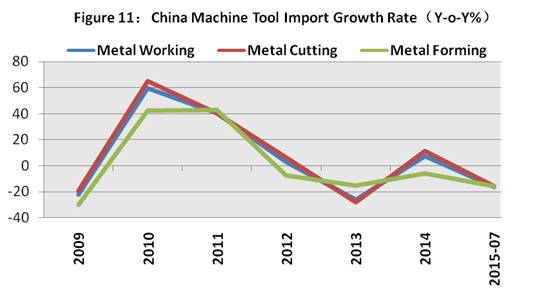
DataSources:General Administrationof Customs of the People’s Republic of China
Below is the introduction to theimport situation of metalworking machine tools in Jan.-July this year. Figure 12 is the distributionof the structure of all machine tool & tool products imported from Jan toJuly. It can be seen that the total amount of machine tool & tool productsimported was USD 8.87 billion, of which the metalworking machine tools (metal cuttingmachine tool + metal forming machine tool) imported amounted to USD5.16 billion,accounting for 58%; the import amount of machine tool functional parts andnumerical control device were USD2.11 billion, accounting for 24%; the amountof cutting tool imported was USD790 million, accounting for 9%; the amount of otherproducts imported was USD1.94 billion, accounting for 9%.
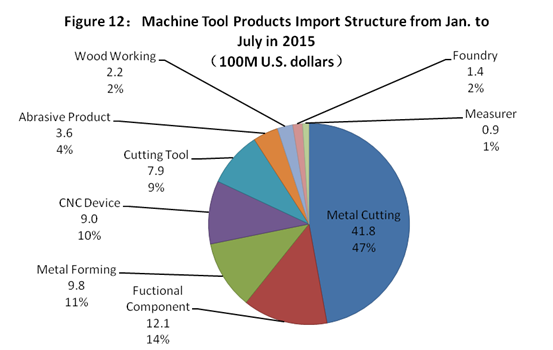
DataSources:General Administrationof Customs of the People’s Republic of China
Next, we will introduce theimport situation of metalworking machine tools to you.
Figure 13 is the distributionsituation of imported machine tools by categories. The data shows that thesequence of categories with larger import values are the machining center,grinder, non-traditional machine tool, lathes and punching shear machine tool. Thetotal import amount of the five categories of machine tool was USD 4.11 billion,accounting for 79.9%.
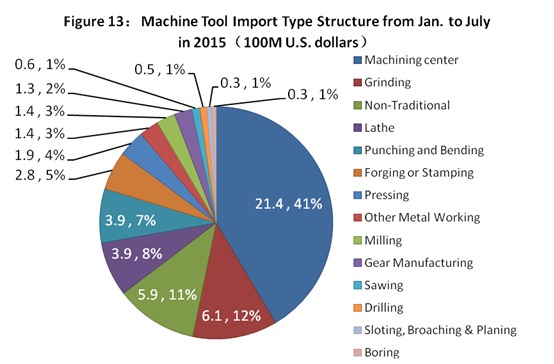
DataSources:General Administrationof Customs of the People’s Republic of China
Figure 14 is the distributionsituation of imported machine tools by origin. The data shows the sequence of countriesand regions with larger import amount by China are Japan, Germany, Taiwan,South Korea and Italy. The total amount of imports from countries and regionabove mentioned by China reached 4.21 billion USD accounting for 81.6%.
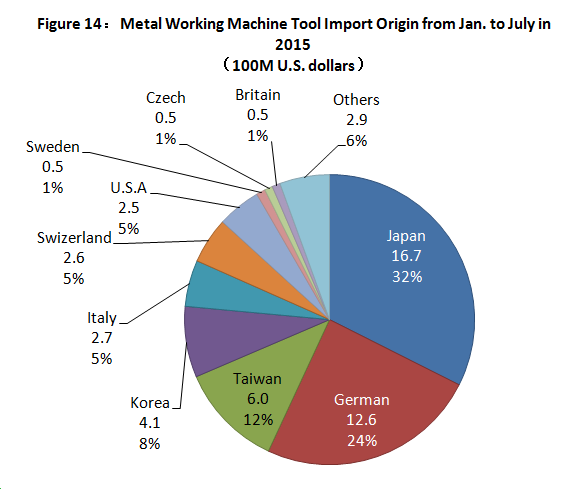
DataSources:General Administrationof Customs of the People’s Republic of China
Figure 15 is the distribution situationof imported metal cutting machine tools by origins. The data shows the sequenceof countries and regions with larger import amount by China are Japan, Germany,Taiwan, South Korea and Switzerland. The total amount of imports from the saidcountries and region reached USD 3.53billion, accounting for 84.4%.
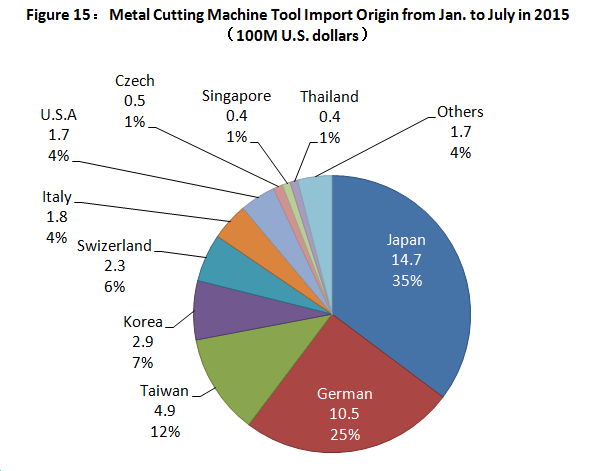
DataSources:General Administrationof Customs of the People’s Republic of China
Figure 16 is the distribution situationof the origins of the metal forming machine tool imported. The data shows thesequence of countries and regions with larger import amount by China areGermany, Japan, South Korea, Taiwan and Italy. The total import amount from thesaid countries and region by China reached USD 730 million, accounting for74.5%.
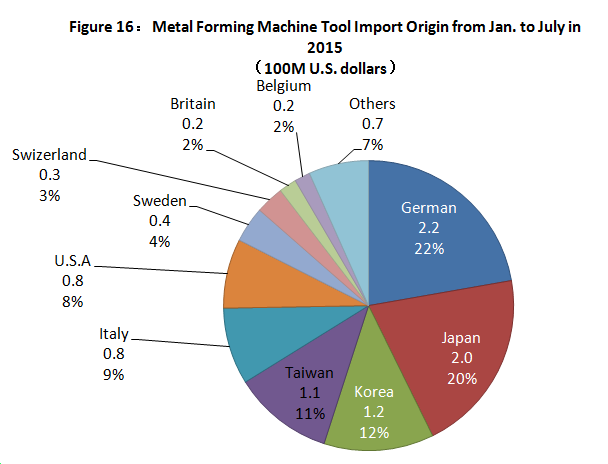
DataSources:General Administrationof Customs of the People’s Republic of China
3, CCMT2016
China CNC Machine Tool Fair 2016(CCMT2016) will be held at New International Expo Center in Shanghai on April11-15, 2016. Currently the exhibitor-inviting for the fair is being carried outsmoothly. Other preparatory work has also been fully launched.
China CNC Machine Tool Fair initiatedin Shanghai in 2000, as a professional exhibition of machine tool & tooland its supporting products. It is held every two years. 8 sessions have beensuccessfully held already with Shanghai (5), Beijing (1) and Nanjing (2).According to the initial positioning of the Fair, the first 7 Fairs were mainlyfor domestic exhibitors. Since 2014, the fair moved back to Shanghai. At thesame time, the organizer reestablished its development direction proposing theupgraded goal of "international, professional, and informational",officially started the transition to internationalization for the fair.CCMT2014 exhibition area was 100,000 square metersattracting 910 exhibitors from 20 countries and regions in total to participatein it. Among them 276 are overseas exhibitors, accounting for 30% of the totalnumber of exhibitors. The exhibition net area of overseasexhibitors was 15,259 square meters, accounting for 27% of the total area ofthe exhibition. The audience was up to 143, 000 man/time. The transition tointernationalization for the fair has achieved initial success!
CCMT2016 will continue topromote the upgrade process of "international, professional, and informational".Compared with CCMT2014, the new progress of this fair is mainly reflected inthe following aspects:
- The exhibition area reaches120,000 square meters, which is an increase of 20% over the previous session;
-10 formal exhibition halls inShanghai New International Expo Center will be employed. The temporaryexhibition halls for the past fairs are canceled;
- The exhibition area foroversea exhibitors will exceed 40% of the total. The internationalization levelof the fair will be further improved;
- Exhibitors registration,audience registration, information dissemination and other exhibitionmanagement procedures all use information technology to provide more convenientservice to the participants;
- For forwarders, exhibitionconstruction and other major supporting service providers, we re-organized thebid selection. The competition mechanism will promote the service level to besignificantly improved;
- Adjust the booth charge andcollection method, which further narrow the price difference between domesticand oversea exhibitors and introduce the market principle of high quality andlow price;
- Further optimize the structureof exhibits, expand the show area for the smart technology, industrial robots,and material additive manufacturing;
- To further promote theprofessional exhibition planning, try to best optimize layout arrangement accordingto the categories of exhibits to provide convenience to visitors and purchasersfor choosing equipment.
At the same time, during the fair,rich and colorful activities will be held to provide a full range of servicesfor exhibitors, the audience and the media.
As everyone knows, with China'scomprehensive reform and structural adjustment deepening, China's economicdevelopment environment is taking place for long-time positive change.Simultaneously, China's machine tool consumer market and China's machine tool& took industry are experiencing a profound adjustment. The old marketpattern is changing, and the new market pattern is forming. In compliance withthe above changes, we want to take new actions, so we established the theme ofCCMT2016 as "New Environment·New Pattern·New Action".
Welcome the global exhibitorsand the audience to participate in CCMT2016. Let us use CCMT2016 as a displayand communication platform to stride together towards anew future.


 京公网安备11040302100005 京ICP备05015583号-2
京公网安备11040302100005 京ICP备05015583号-2  Jing Gong Wang An Bei No.11040302100005 05015583-2, No. , Beijing
Jing Gong Wang An Bei No.11040302100005 05015583-2, No. , Beijing

 京公网安备11040302100005 京ICP备05015583号-2
京公网安备11040302100005 京ICP备05015583号-2  Jing Gong Wang An Bei No.11040302100005 05015583-2, No. , Beijing
Jing Gong Wang An Bei No.11040302100005 05015583-2, No. , Beijing